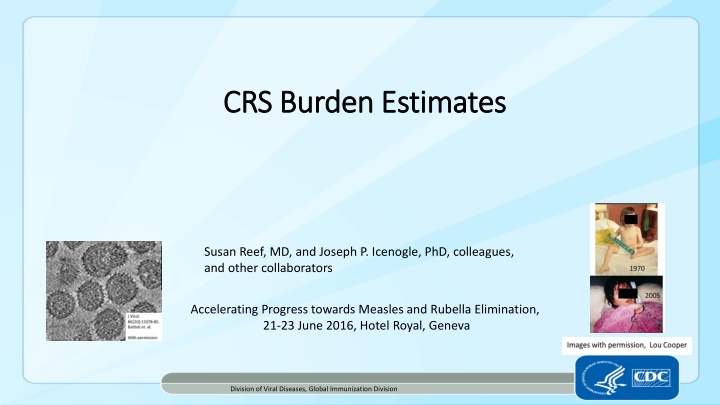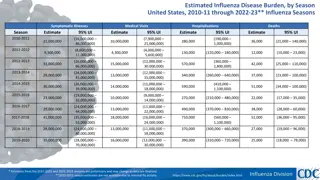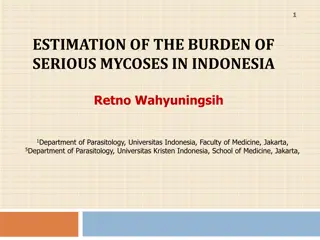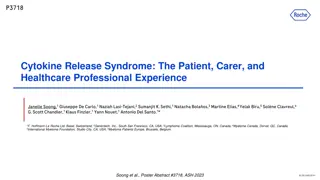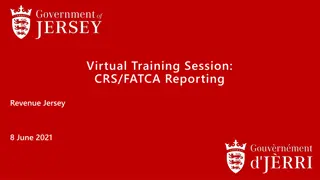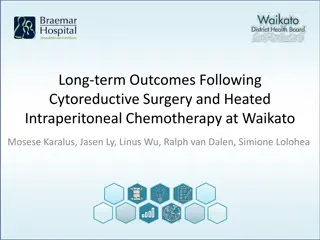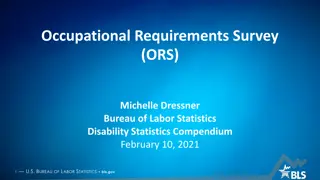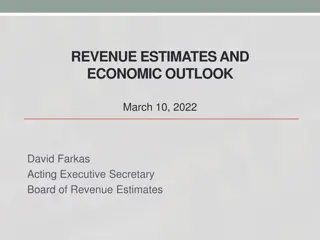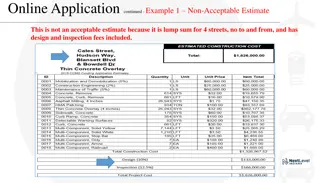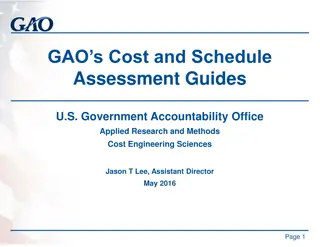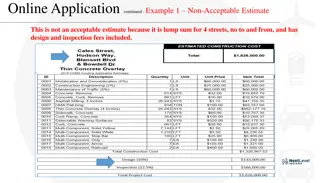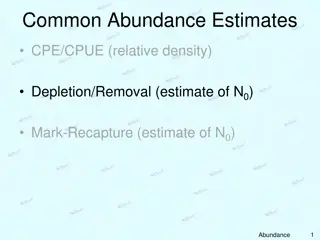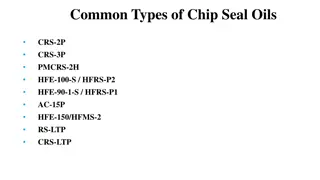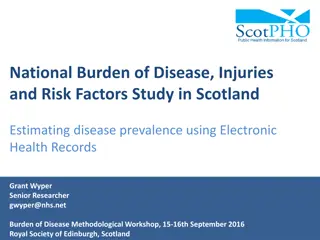CRS Burden Estimates
The purpose of rubella vaccination programs is vital for preventing and eliminating congenital rubella infections. Identifying children with Congenital Rubella Syndrome (CRS) can be challenging as many cases go undetected. This content delves into CRS case definitions, WHO criteria, and classification, assisting healthcare workers in efficiently identifying and managing suspected cases. Understanding these criteria is crucial for monitoring vaccination programs and achieving the goal of eliminating CRS.
Download Presentation

Please find below an Image/Link to download the presentation.
The content on the website is provided AS IS for your information and personal use only. It may not be sold, licensed, or shared on other websites without obtaining consent from the author.If you encounter any issues during the download, it is possible that the publisher has removed the file from their server.
You are allowed to download the files provided on this website for personal or commercial use, subject to the condition that they are used lawfully. All files are the property of their respective owners.
The content on the website is provided AS IS for your information and personal use only. It may not be sold, licensed, or shared on other websites without obtaining consent from the author.
E N D
Presentation Transcript
CRS Burden Estimates CRS Burden Estimates Susan Reef, MD, and Joseph P. Icenogle, PhD, colleagues, and other collaborators Accelerating Progress towards Measles and Rubella Elimination, 21-23 June 2016, Hotel Royal, Geneva Division of Viral Diseases, Global Immunization Division
Background The purpose of any rubella vaccination program is prevention/elimination of congenital rubella infections Identification of children with CRS can be challenging Up to 50% of mothers who give birth to infants with CRS are asymptomatic or without rash and would not be identified as rubella cases Identification of children with CRS used for advocacy monitoring vaccination program need to measure the impact documenting the elimination of CRS
CRS Case Definitions CRS Case Definitions Suspected CRS (to be investigated): Any infant less than one year of age in whom a health worker suspects CRS. A health worker should suspect CRS when an infant presents with heart disease and/or suspicion of hearing impairment and/or one or more of the following eye signs: white pupil (cataract), or larger eye ball (congenital glaucoma) or pigmentary retinopathy. an infant s mother has a history of suspected or confirmed rubella during pregnancy, even when the infant shows no signs of CRS.
WHO CRS case definitions Clinical criteria for CRS: Presence of 2 clinical features from group A or 1 feature from group A and 1 feature from group B: (A) cataract(s), congenital glaucoma, congenital heart disease, hearing impairment, pigmentary retinopathy (B) purpura, splenomegaly, microcephaly, mental retardation, meningoencephalitis, radiolucent bone disease, jaundice with onset within 24 hours after birth
WHO CRS case Classification Clinically-compatible: A suspected case which meets the clinical case definition and without any other obvious clinical cause that has not been adequately tested by laboratory Confirmed: A suspected case with one clinical defect from group A that is laboratory confirmed Congenital rubella infection (infection only): A case that demonstrates laboratory evidence without any clinical defect from group (A) Discarded: A suspected case that does not meet the definition of clinically-compatible and with a negative laboratory results from adequate testing * *Adequate testing is defined as follows: at least 200 l serum is obtained (from a minimum of ~0.5ml of blood); serum sample is stored in the refrigerator or on ice prior to reaching the laboratory and shows no sign of being subjected to heat; serum is tested for rubella-IgM, and if the infant is 6 12 months of age and IgM-negative, tested at least twice for rubella-IgG as required by the testing protocol.
Surveillance classification of suspected CRS case-patients up to 6 months of age SuspectedCRS case <6 months of age 6 to <12 months of age Blood sample not obtained Blood sample obtained (1ml) IgM IgM + Meets clinical criteria for CRS Does not meet clinical criteria for CRS Absence of 1 defect from (A) Presence of 1 defect from (A) Within 1st month of life, and high suspicion of CRS Infection only (CRI) Clinically compatible Confirmed Discarded Discarded Follow up test 1-2 mos. later IgM+ IgM - Discarded Confirmed
Surveillance classification of suspected CRS case-patients 6 to <12 months of age SuspectedCRS case <6 months of age 6 to <12 months of age Blood sample not obtained Blood sample obtained (1ml) IgG + and IgG+ and IgG and IgM IgM + IgM + / IgM 2nd blood sample obtained 2nd blood sample not obtained Discarded IgG IgG + Meets clinical criteria for CRS Does not meet clinical criteria for CRS Absence of 1 defect from (A) Presence of 1 defect from (A) Infection only (CRI) Clinically compatible Confirmed Discarded Discarded
Proposed Congenital Rubella Syndrome Surveillance Performance Indicators Criteria Indicator Minimum threshold Reporting rate National annual rate of suspected CRS cases 1 per 10 000 live births Adequate investigation % suspected CRS cases with the following data points completed: name and/or identifier, place of residence, sex, date of birth, date of reporting, date of investigation, date of specimen collection, history of rash illness of mother, travel history of mother, vaccination history of mother; age of mother; clinical examinations for hearing impairment, cataract, and congenital cardiac/ heart defects and clinical outcome of the CRS case (alive or dead) % suspected cases with adequate blood specimen tested for laboratory confirmation (IgM/ IgG, PCR) in an accredited laboratory. % confirmed cases with adequate specimens tested for virus detection/isolation 80% Laboratory confirmation (adequate specimen rate) Viral detection (adequate specimens for virus detection) Monitoring of virus excretion 80% 80% % confirmed cases with at least 2 negative tests for virus detection/isolation after 3 months of age with at least a one month interval between specimen collection % of confirmed CRS cases detected within 3 months of birth. 80% Timeliness of detection 80% Proportion of specimens (serologic or virologic) received at the laboratory within 5 days of collection Proportion of serologic results reported by the laboratory within 4 days of receiving the specimen Timeliness of specimen transport 80% Timeliness of reporting laboratory results 80%
Surveillance classification of suspected CRS case-patients 6 to <12 months of age Special Circumstances Unlike persons with rubella, infants with CRS may shed virus for a prolonged period (3-4 months is typical) and can often be confirmed by detection of virus or virus genome (RT-PCR).
Surveillance classification of suspected CRS case-patients 6 to <12 months of age Special Circumstances Risk of suspect CRS case having had postnatal rubella may need to be assessed (i.e. not CRS but had postnatal rubella).
DALYS and Mortality associated with CRS CRS is associated with significant morbidity and mortality Cost per Congenital Rubella Syndrome (CRS) case $11,300 for LOW to $934,000 for HIGH reflects lifetime of chronic care for individuals with disabilities CRS DALYS: Higher than DALYs associated with measles and rubella The estimated DALYs associated with the income level of country High, Upper Middle, Lower Middle, Low 18.7, 22.3, 27.5, 28 Mortality Estimated mortality has ranged from 20-33% Recent publications confirm significant mortality o (e.g. recent work from Romania*) Infants born with cardiac defects have the highest risk of mortality *Lazar et al., Eurosurveillance In Press
Development Detailed characterization of fatal cases Case 1. Multiple defects Including pulmonary hypertension. anti-RV polyclonal antibody Pulmonary histopathologic and immunohistochemical features in a fatal CRS case. (A) Low-power image of lung shows congestion, edema, mild interstitial inflammation and hyaline membrane formation. (B) Diffuse alveolar damage and interstitial pneumonitis. (C) High-power image shows intra-alveolar macrophages. (D) Rubella virus antigens in intra-alveolar macrophages. Note immunostaining of globular inclusions.
Challenges/Developments Clinical manifestations may not be manifested within the first year of life (after which laboratory confirmation is not currently possible) Health care system may not have the technology (e.g., hearing testing) to detect the defect Chronic disability and death may be underestimated in infants/children with CRS depending on the follow-up of the infants with CRS Laboratory confirmation for infants => 6 months, may be challenging to get second specimen for IgG testing. Evaluating if only one IgG is sufficient in special circumstances Adding viral isolation and RT-PCR to the algorithm Development of global CRS surveillance performance indicators
CRS Burden Estimates CRS Burden Estimates Susan Reef, MD, and Joseph P. Icenogle, PhD, colleagues, and other collaborators Accelerating Progress towards Measles and Rubella Elimination, 21-23 June 2016, Hotel Royal, Geneva Division of Viral Diseases, Global Immunization Division
